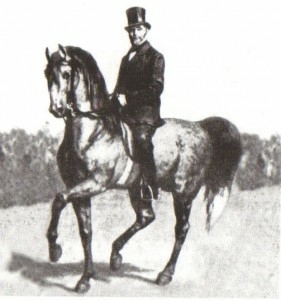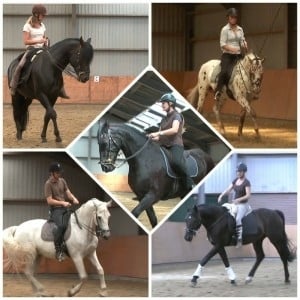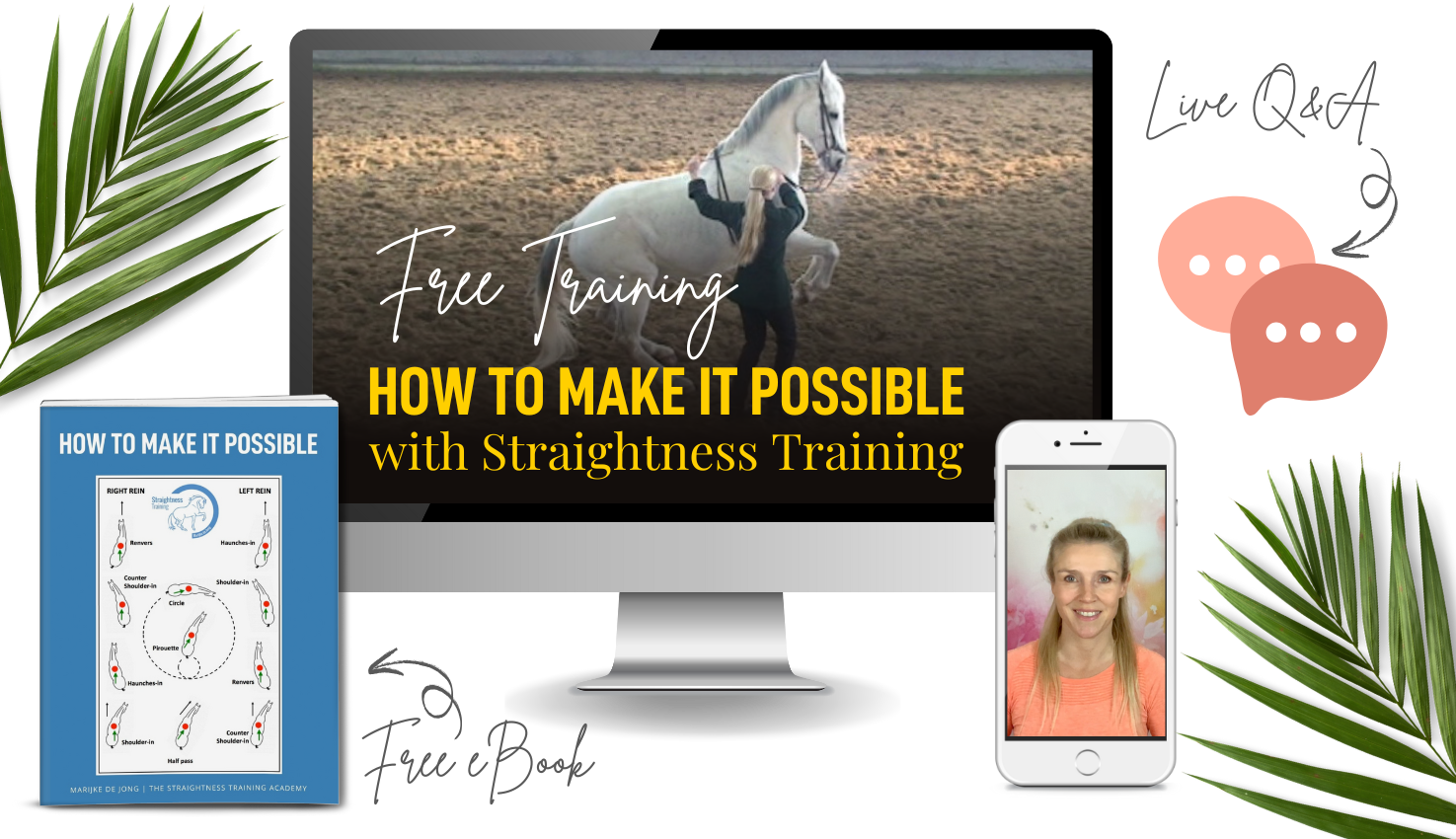
12 Tips for Objective Observation

It is not always easy to make an objective observation about our horse.
On the contrary:
We are great at making assumptions with their horse:
- Most horses are left bended.
- All left-bended horses have their mane to the right.
- All right-bended horses are left handed.
- All low spirited horses are lazy.
- Coldblood horses can’t do the piaffe.
The following story illustrates this assumption-making process:
“All sheep are white…”

Five scientists sit on the train and travel through Scotland. They look out the window and see a sheep in a pasture.
- Scientist #1 says: All sheep are white.
- Scientist #2 says: No, all sheep in Scotland are white.
- Scientist #3 says: No, all sheep in this pasture are white.
- Scientist #4 says: No, this sheep is white.
- Scientist #5: we can say with certainty that this sheep is white on this side.
So let’s dive a bit more into the tendency to generalize.
Generalization
Taking something specific and applying it more broadly is making a generalization.
It’s a generalization to say all horses are herbivores.
A generalization is taking one or a few facts and making a broader, more universal statement.
But be careful:
If all the horses you know are right bended, you might make the generalization and belief that all horses are right bended.
It is interesting to see that there are different generalizations about the natural asymmetry of horses:
There are more left-bended horses according to: | There are more right-bended horses according to: |
|
|

And maybe you have 4 left bended horses yourself, but your specific personal experience is perhaps not a reliable picture of the overall reality.
Scientifically it is not proven that there are more left-bended horses than right-bended or vice versa, but so general ‘beliefs’ can be very powerful.
Usually, it’s best to stick with specifics and avoid ‘beliefs’ and generalizations.
However, scientists try to make generalizations based on research.
Facts Which Influence “The Truth”
We can not easily say that something is ‘ALWAYS this’ or ‘NEVER that’, even when it’s been scientifically proven.
Because even with scientific general overarching truths, it’s always important to know on what facts these truths are based on:
1. Small Or Large Numbers?
Sometimes a scientific study has involved very small numbers.
So if a study has been done with only ten horses, the results are probably not a reliable picture of the overall reality.
So the more data, the more accurate the generalization.
2. What Are The Circumstances?
If the scientific relates to a population or set of circumstances quite different from what is in front of us:

For example, the study is done for example with warmbloods, but we have a Norwegian, Frisian, or Icelandic horse.
Or, when a saddle or bareback pad is tested, what about the rider and what about the girth?:
- Hungarians ride without a girth and are very much in balance.
- An unbalanced rider will slide with the bareback pad or saddle to one side, so he will tighten the girth too much to avoid this sliding, and this causes pressure on the spine and back muscles.
- A rider with an independent seat and independent functioning seat bones will move as in salsa, so he will adjust with the seat bones to the movement of the back, so that won’t cause any pressure, because he’s melting together with the seat.
- A rider without independent seat bones and a fixed seat will influence the horse’s back, because he’s riding the horse as if it was a kangaroo, going with two seat bones at the same time forward, so that he will press the back with the seat bones in every step.
So whatever scientists say about the saddle, it depends also on what rider they used in the tests: If they used a Hungarian rider, or an Indian, without a girth or with a loose girth, they might not have found any pressure points on the back of the horse. But if they used a stiff, fixed, kangaroo-style rider, and/or a tightened girth, then they will get another outcome.
3. Is The Study Easy To Repeat?

Then, some scientific studies are difficult to repeat, and when repeated, they give a totally different outcome. But a test with four warmbloods, all the same age, trained in a certain way, with a certain type of saddle and a certain style of riding, should have the same results when repeated a year later.
It is like when someone has baked a great cake, and someone else wants to bake that same cake.
He asks the cake baker what he needs:
– The recipe
– The ingredients
– The materials
Of course, 100% equal, the cakes will never be, but when the cakes are quite equal, that is a good sign.
However, when the outcome is totally different, then several conclusions are possible:
- The second cake baker did something wrong,
- The first cake baker didn’t explain well enough what he did,
or – and that is the most interesting –
- The first cake baker has less understood how he produced the cake than he thought! So his conscious intellect is not congruent with his unconscious experience.
Absolute Truth or Opinion?

Different facts might lead to different ‘truths’.
And sometimes a study based on poor facts might lead to ‘an opinion’.
Of course, it would be great if we could rely on an ‘absolute truth’.
On something that is ‘waterproof’.
Then horse training would be 100% safe!
Because we could never do it ‘wrong’!
And all of us would be fabulous horse trainers who never fail.
However, we should grow beyond our ‘blue’ level of consciousness.
Because the map is never the territory.
Which means, reality can never be described in precise and full details.
And it’s always the human behind the map that determines what the outcome of the navigation through the real landscape is.
Plus, as long a horse is of flesh and blood we to adapt to the individual horse with a tailor-made approach.
Tailor Made Approach
Therefore, remember the sheep story!

When testing a saddle, training a horse, or whatever study we’re doing, we can say with certainty that:
- this horse,
- of this age,
- in this equestrian discipline,
- with this amount of weeks/months/years of training,
- with this amount of muscles and
- this amount of self-carriage in body and mind,
- with this rider,
- with this timing and dosing of pressure and release, and
- this influence of the seat, leg, aids,
- with this temperature of the weather,
- with this kind of warming up
shows symptoms XYZ at this moment.
This means, we cannot rely on the science of training, the theory, and our logical, analytical, conceptual, rational thinking only:
We also need the art of training, our feel, intuition, experience and observation skills.
12 Tips on How To Improve Your Observation Skills
To be able to observe objectively as scientist #5 above is a key to good horsemanship. Every horse needs an individual and trailer-made approach, and it all starts with objective observation.
These tips might help:
1. Never Assume
For example, don’t make the assumption that a left-bended horse is ALWAYS right-handed. Never assume that a lazy horse is ALWAYS less intelligent. Avoid generalizations. Stick with specifics. A good observer never assumes, ignores their personal feelings, and sees things for what they are.
2. Don’t Compare
Never compare your horse to your former horse, and also not to another horse of the same age. Horses have different learning abilities and absorb information at different rates.
3. Stay In The Now
Riders tend to treat the horse as they think he is. And this often leads to “self-fulfilling prophecy”. But the past doesn’t equal the future. So don’t let the past hinder your progress. Let it go. Just do as horses do: horses live in the moment every single day. That’s why they can quickly overcome years of behavioral and physical issues with the proper guidance.
4. See The Bigger Picture.
Sorting ideas into tidy little boxes can cause problems during training. It sometimes prevents us from seeing the Bigger Picture. So take care not to make conclusions based on one single aspect, part, picture, or split second in time. Instead, see all aspects, parts, pictures and moments, instead of just a single aspect, part, picture or moment. See all things as part of a big, mysterious puzzle called Straightness Training, where every idea and every concept is part of something bigger.
5. Use All Your Senses.
‘See’ your horse, ‘hear’ your horse, ‘listen’ to your horse, ‘feel’ your horse. That means, see his movement, hear the rhythm of the gait, listen to his breathing, feel his muscle tension, and sense your horse’s energy, emotions, and attitude.


6. Test What You See, Hear or Feel.
Not everything is what it seems. Often a single picture might ‘preframe’ you to see something. But when you see the Bigger Picture – including the moments before and after – the world might look completely different.
7. Avid Labels.
The first impression is important, but does not always paint the true picture. Riders form a picture of a horse very quickly and easily. They’d like to label. But do not judge too quickly. Try to be as unprejudiced as possible. To be a good observer, you must be neutral.
8. Observe Consciously.
Here’s a secret: Little of our mental processes are conscious. In fact, 95% of our brain activity is beyond our conscious awareness. And these unconscious mental processes act to alert us to things that our rather slow conscious mind may not be aware of. Such as implicit things, and subtle things. Therefore, when observing, look for underlying details in even the simplest things. Paying attention to things that might seem insignificant makes you conscious of your surroundings. This makes you a better observer.
9. Empty Your Cup
Dare to think outside the box during your training. Be creative and curious. Be open-minded and imaginative, that will make you a better observer.
10. Keep a Beginner’s Mind
Be mindful of your surroundings, especially ones that you think you’re already familiar with. Keep a beginner’s mind and challenge yourself to pay attention to new things.
11. Look For Learning, Not Teaching
When training a horse, we often want to ‘produce’ and teach him things, but our horse is our best teachers. By observing our horse, we learn the effects of our approach. And we learn what’s working, and what’s not working. And that makes us better teachers.
12. Grow Your Experience
One rider is naturally a better observer than the other. And the trained and experienced trainer happens to have a sharper eye than a novice or inexperienced rider. But practice makes perfect, and after a while, it gets better.

